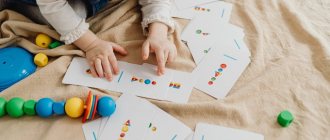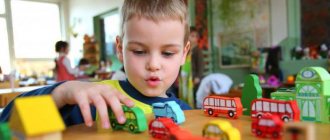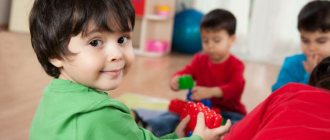Age norms for speech development at 2-3 years
Each age has its own vocabulary, certain pronunciation skills, and the degree of understanding of other people’s speech. So, the baby babbles his first words at the age of about a year. At first they are indistinct, but over time they become more and more clear. By the age of 2-3 years, the basic speech base is already formed, therefore, from birth to 3 years, you need to pay special attention to the development of the baby’s speech.
Speech norms for children 2-3 years old :
- The vocabulary of a 2-year-old child is approximately 200-300 words, and after six months the number of words reaches 1000-1200. More than half are nouns, with verbs in second place. By the age of three, the active use of adjectives, pronouns, adverbs, prepositions and conjunctions begins.
- The child is able to construct simple sentences of 2-3 words, explain what he needs, and communicate with peers. These are mostly declarative or exclamatory sentences. Single words are used as questions: where, how, why.
- The child names the size of the object (large - small), color, taste (sweet - salty - sour), shape (circle - square), quality (bad - good).
- Generalizing words appear in speech. For example, an orange, an apple, a pear are fruits, shoes, slippers, boots are shoes.
- Lightweight words like “bi-bi” and “tu-tu” disappear from speech.
- The baby understands the adult’s address to him.
- Incorrect use of declensions, numbers and genders is possible. By the age of three, their use should correspond to the language norm.
- Children at this age love to invent their own words. Substitutions of letters are possible, syllables in long words are swapped or shortened. For example, a spatula is a shovel, Vaseline is majeline, etc.
- Two-year-old children have difficulty pronouncing hissing sounds, replacing them with whistling sounds. Hard sounds are often replaced by soft ones, and this is normal. Some children already pronounce most sounds by the age of three, even the most complex ones - l, r.
Communication with parents and loved ones is the main source of information for a child. He unconsciously copies those with whom he is close.
Advice At the age of 2-3 years, the child’s attentiveness increases, he begins to listen to the speech of others. Children are very sensitive to the norms of language, so it is important to speak to them correctly: pronounce sounds clearly, do not lisp, use understandable words, take your time, speak with expression.
From the author
The successful implementation of program objectives depends on a number of factors and, above all, on the way of life of a preschool institution, the atmosphere in which the child is raised, and on a specially designed, thoughtful developmental environment.
The effectiveness of education and training is achieved through the painstaking work of teachers who work directly with children and all preschool employees who communicate with preschoolers during the day.
The system of work on teaching children their native language, introducing them to fiction is presented in the works of V. V. Gerbova “Development of speech in kindergarten”, “Introducing children to fiction” (M.: Mozaika-Sintez, 2005).
The manual “Classes on speech development in the first junior group of kindergarten”, written within the framework of the “Program of education and training in kindergarten” edited by M. A. Vasilyeva, V. V. Gerbova, T. S. Komarova, supplements recommendations on the most important direction of pedagogical activity - purposeful and systematic training of preschoolers in the classroom. The practical purpose of the book is to provide educators with approximate guidelines for planning lessons (defining topics and learning goals, ways to implement them).
Summary of educational activities for speech development in the nursery group “Our Pets”.
Summary of GCD for speech development
in the nursery group “Our Pets”.
Objectives: expand children's knowledge about domestic animals; enrich your vocabulary, name animals and actions (the concept of “pet” is in the passive dictionary); continue to learn how to construct sentences and answer questions; encourage them to be active and
independence.
Material: bag with animal toys (cow, horse, dog, cat, goat, pig).
Progress of the lesson
The teacher calls the children over and asks: “Look, guys, what is this magic bag we have here, who is hiding in it?” A voice is heard: “We! We!" "Who is this?"
He looks into the bag and asks in surprise: “Who is scratching here? What do you guys think?”
Cat
On the balcony outside the window there is a black and white spot. Now curled up, now sideways, Watching the sun with his eye. Ears, eyes, tail and paws, This is a Tsap-scratch cat. — A cat’s child is called a kitten. The kitten says: “Meow-meow.” Say it like a kitten says.
The teacher takes out a toy and asks to name who it is. Cow
A cow has horns and hooves on its legs. She chews grass and gives milk to the children. — A cow’s child is called a calf. The calf says: "Moo-oo." Say it like the calf says.
Another voice is heard: “Igo-go!” "Who is this?" Horse
The horse has a long mane and has a cheerful and playful disposition. She will eat the hay now, and give us a ride. - A horse's child is called a foal. The foal says: “i-go-go.” Say it like a foal says.
The teacher takes out a horse and invites the child to take a toy, asks questions: “Who saw the horse? Who was riding a horse? What was she like? Encourages children's initiative and their desire to answer independently.
The teacher continues: “Who else lives next to us? Woof! Woof! Woof! Who
This? Dog Bug. What does she ask the guys? A bone. Dog
The dog gnaws bones, bites evil people too - so that a thief does not get in, guards both the house and the yard. -A dog’s baby is called a puppy. The puppy says: “woof-woof.” Say it like a puppy says.
The teacher looks into the bag: “Who else do we have here?” Goat
The jumping goat, mischievous, butting, likes to sneak, eat cabbage from the garden. — A goat’s child is called a kid. He says: “Me-e-e.” Say it like the little goat says.
The teacher continues: “Who is this left in our bag?” Pig
The dirty pigs have bristles on their backs, a snout on their faces, and a thin hooked tail on their backs. - A pig's child is called a piglet. The pig says: “oink-oink.” Say it like the pig says.
These guys are all pets.”
At the end of the lesson, you can offer to play with animal toys:
build them houses, feed them, while asking questions:
“What he loves”, “What we will feed.” The teacher supports and encourages
children's initiative.



